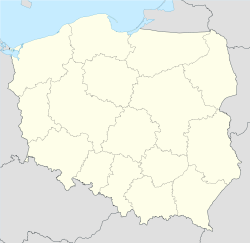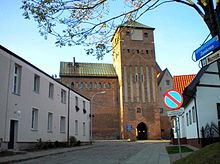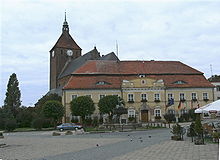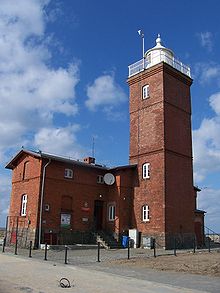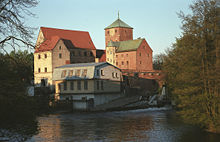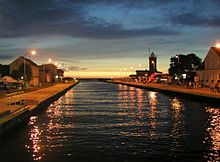- Darłowo
-
Darłowo 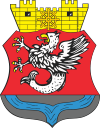
Coat of armsCoordinates: 54°25′N 16°25′E / 54.417°N 16.417°E Country  Poland
PolandVoivodeship West Pomeranian County Sławno Gmina Darłowo (urban gmina) Area – Total 19.93 km2 (7.7 sq mi) Highest elevation 5 m (16 ft) Lowest elevation 1 m (3 ft) Population (2006) – Total 14,380 – Density 721.5/km2 (1,868.7/sq mi) Postal code 76-150 and 76-153 Website http://www.darlowo.pl/ Darłowo [darˈwɔvɔ] (in full The Royal City of Darłowo: Polish: Królewskie Miasto Darłowo, German: Rügenwalde) is a town at the south coast of the Baltic Sea in Middle Pomerania, north-western Poland, with 14,931 inhabitants (2006). Located in Sławno County in West Pomeranian Voivodeship since 1999, it was previously a town in Koszalin Voivodeship (1950–1998).
Contents
History
Numerous archeological findings reveal that, after the ice which had covered North-Eastern Europe had molten and the Ice-age had ended at about 8.000 B.C., settlers of the Stone Age first populated the region.[1] Remainders of Celtic culture and Germanic culture, as well as of Baltic culture, influenced by contacts with Rome's merchants, were found in the area. Several Roman coins with portraits of Roman Emperors were found around Darłowo.[citation needed]
On Ptolemy's chart of Germania Magna a settlement of the Rugians called Rugium is listed in the vicinity of a river which probably is identical with the Grabowa River flowing into the Wieprza river.[2][3]
Middle Ages
Already in the 11th century a fortress named Dirlow, also called Dirlovo, existed in the immediate vicinity of the place where the River Wieprza enters the Baltic Sea.[4] From this fortress, the fortress district of Dirlow was administered, which itself belonged to the castelany of Schlawe. The town of Rügenwalde was later founded in the fortress district of Dirlow, but not at the location of the fortress itself.
The town of Rügenwalde was probably founded in 1270 by Wizlaw II of the Danish Principality of Rügen, at that time also ruler of the Lands of Schlawe and Stolp. The first mention of Rügenwalde is in a document of February 5, 1271.[5] The settlement decayed.[6][7]
In 1277, Wizlaw II had sold his rights concerning the lands of Rügenwalde and Schlawe to the margraves of Brandenburg, who thereafter ruled these lands from Buckow up to the year of 1283.[8] According to a Polish encyclopedia, the town of Rügenwalde has been destroyed in 1283 during fights between Wizlaw II and Mestwin II (Polish: Mszczuj or Mściwój).[9] In a chronic of 1652, M. Merian stated that it had been destroyed on purpose by Bogislaw of Pomerania, when after Mestwin's II death in December 1294 duke Przemysŀ had claimed the town for Pomeralia, as he had done already five years before, and could not be persuaded to peacefully give up his claim and to withdraw from there.[10] In a decisive battle of 1296, the Polish invasion troops were beaten near the village of Buckow by a Pomeranian contingent led by duke Wizlaw of Rügen and count Adolph from Holstein. The retreating Polish troops devastated the castle of Dirlow and the town once more.
Rügenwalde was built new and on May 21, 1312, the town was granted Lübeck law under the administration of the noble brothers John, Peter, and Lawrence[11] of the Swenzones,[12] vassals of the Brandenburg margraves since 1307.[13][14][15] The Ascanians had already been prior to 1307 under control of the Lands of Schlawe and Stolp.[16] In Rügenwalde they had been already in 1305.[17] They undertook in 1308 a campaign against Gdansk.[6][18][19][20]
The town passed to the Duchy of Pomerania in 1347,[21] at that time ruled by the brothers Bogislaw V, Wartislaw V, and Barnim IV of the House of Pomerania dynasty. Bogislaw, son-in-law of king Casimir III of Poland, would become ruler of the area after the partition of Pomerania-Wolgast in 1368. This part duchy was known as Pomerania-Stolp.
Transition to Modern Times
In 1352 the construction of the castle began, and cooperation with the Hanseatic League (Hanse) was initiated, with the town becoming a full member of the Hanse in 1412. In 1382 Eric of Pomerania, later the king of Norway, Denmark and Sweden, was born in the town. After losing his thrones, he returned to his birthplace and began to expand his duchy. After his death in 1459 he was buried in St. Mary's Church.
After Eric's death the town was ruled by duke Eric II of Pomerania-Wolgast.[22]
Another significant ruler was Bogislaw X (1454–1523). Under his administration the trade and prosperity in the area of Darłowo grew, as international trade relations were extended, also with Poland.
In 1497 and 1552 the harbour of the town, known in German as Rügenwaldermünde, and parts of the town were hit by great storms. Ships which had got out of control were seen drifting in the vicinity of the town and of the neighbouring village of Suckow. In 1589, 1624, 1648, 1679 and 1722 fires damaged the town. The first lighthouse was built around the year 1715.
After the death of the last Pomeranian Duke Bogislaw XIV in 1637, the end of the contemporary Thirty Years' War in 1648 and the subsequent partition of the Duchy of Pomerania between the Swedish Empire and Brandenburg-Prussia in the Peace of Westphalia and the Treaty of Stettin (1653), Brandenburg included Farther Pomerania with Rügenwalde in her Pomeranian province. The harbour of Rügenwaldermünde was destroyed during the Thirty Years' War by imperial troops, and was reconstructed by order of King Frederick II of Prussia not before 1772.
19th and 20th Century
During the Napoleonic Wars some of its inhabitants, in particular ship owners and businessmen, profited from smuggling British goods to the continent. In 1871 the town, along with Prussia, became a part of the reconstituted second German Empire. A railway reached the town in 1878. 289 inhabitants died throughout World War I.
In last democratic elections March 5, 1933, 58.13% (Germany 44%) valid votes for NSDAP (data for the county) .
Before the outbreak of World War I the town had about 6,000 inhabitants, before the outbreak of World War II about 8000. As a town in the middle of Farther Pomerania, it had a population of German native language, with a negligible number of exceptions.[23]
In 1935 the important Firing Test Range Rügenwalde-Bad (German: Schießplatz Rügenwalde-Bad), designed for testing heavy guns, including long-range railway type of cannons such as Krupp K5, was built between Rügenwalde's habour Rügenwaldermünde and the village of Suckow.[24] During World War II some of the largest guns in military history were tested here: Schwerer Gustav and Mörser Karl. Gun barrels with a length of up to 47 meters were tested. For long distance tests, target areas within the Baltic Sea North of Großmöllendorf and Henkenhagen (about 80 kilometers away from Rügenwaldermünde) and North of Dievenow and Swinemünde (120 to 130 kilometers away) were used. The test camp was currently visited by officers of the commanding staff of Germany's army, air force and marine, including Admiral of the Fleet Erich Raeder and marshals von Rundstedt, Wilhelm Keitel and Hermann Göring. Once the resort hade been visited also by Adolf Hitler accompanied by Benito Mussolini. Their trains, however, had not stopped at Rügenwalde's train station.
After the End of World War II
During World War II families from the bombarded German towns of Hagen und Bochum in the Ruhr district had been evacuated to Rügenwalde. Short before the end of World War II numerous refugees from East Prussia and West Prussia arrived in the region. In early 1945, about 5.600 persons could escape by ships in the framework of the Operation Hannibal before Soviet Troops reached the town on March 7, 1945. About 3.500 citizens had remained in the town or returned again after their escape had failed.[25]
Following an agreement at the Potsdam Conference, after the end of World War II Rügenwalde was put together with Farther Pomerania under Polish administration. Its thorough German population was expelled[26][27][28] and the town was populated with Poles and Lemkos in 1946/47, who mostly came from regions East of the Curzon Line[citation needed]. The first expulsion of the residual German inhabitants took place on 17 October 1945, followed by a series of further expulsions beginning on 17 August 1946. In 1949 only about 70 Germans were left in the town.
The town was given the Polish name Dyrłów, and later Darłów, before changing to the current name.
Today the city is well known in Poland as a summer resort. A coast aquapark with desalted sea water is available here, the only one in Poland.
Main Sights
The whole area of the Old Town in Darłowo is under preservation. Darłowo has maintained the unique medieval urban planning with the main square in the middle of the town. During medieval times the town was surrounded by walls and had four gates; only one gate has survived in a fairly original shape.
- Castle of Dukes of House of Pomerania - today a Regional Museum.[29] The castle is built in gothic style on a base plan resembling a square; its tower is 24 meters high. This is the only castle of such characteristic on the Polish seacoast.
- Blessed Virgin Mary Church (original German name: Marienkirche) - basilica built in gothic style in 1321, with sarcophagues of Dukes of Pomerania: Erik I, Elisabeth (wife of last Duke of Pomerania Bogislaw XIV, died in 1653).[30]
- Saint Gertrude Church (original German name: Gertrudkirche) - built in Scandinavian style, first mentioned in 1497, built in Scandinavian Style on the little hill Kopfberg outside of the city walls.[31]
- Saint George Church (original German name: Georgskapelle) - built in Gothic style outside of the city walls.[32]
- The town hall re-built in 1657 and in 1725 after damages by fire, with its inscriptions in Latin stating the years of devastation (1589, 1624, 1648, 1679 and 1722).[33]
- The Hanse fountain (German: Hansabrunnen) in front of the town hall, a creation of the German artist Wilhelm Groß (*1883, †1974), donated to the town of Rügenwalde as a present by the local shipping company Hemptenmacher.
- High Gate - also known as Stone Gate (original German names: Hohes Tor or Steintor) - built in the 14th century, a remainder of the city walls.
- Lighthouse - built in the 19th century, 20 meters high
Trivia
The German name Rügenwalde was best known in Germany for the production of the Rügenwalder Teewurst in the town; after World War II the production was restarted in West Germany under the old name.
Demographics
Since the Reformation had taken place in Pomerania, the vast majority of the city's population was composed of Protestants.
Number of inhabitants in years Year Inhabitants Notes 1740 1,973[34] 1782 2,255 incl. 22 Jews[35] 1791 2,331 incl. 29 Jews.[36] 1794 2,347 incl. 29 Jews[35] 1812 3,163 incl. 47 Catholics and 33 Jews.[35] 1817 3,754[37] 1831 3,393 incl. 8 Catholics and 43 Jews.[35] 1843 4,534 incl. 18 Catholics and 67 Jews.[35] 1852 5,060 incl. 16 Catholics and 84 Jews.[35] 1861 5,406 incl. 5 Catholics and 117 Jews.[35] 1875 5,174 1890 5,296 incl. 27 Catholics and 102 Jews 1910 5,978 1939 8,392 1944 approx. 11,000 2008 14, 140 International relations
Twin towns — Sister cities
Darłowo is twinned with:
 Hässleholm, Sweden
Hässleholm, Sweden Nexø, Denmark
Nexø, Denmark Gardelegen, Germany
Gardelegen, Germany Starý Hrozenkov, Czech Republic
Starý Hrozenkov, Czech Republic Saint-Doulchard, France
Saint-Doulchard, France
See also
References
- ^ As an example, near to the village of Schlawin, 10 kilometers away from the town, a 8.5 cm (3.35 in) long axe with a shaft hole, made from diorite, has been found, cf. 40. Jahresbericht der pommerschen Gesellschaft für Geschichte und Altertumskunde, 1877/1878, p. 463.
- ^ Chart Ancient Germany, Harper and Brothers, New York 1849; see External links below.
- ^ Albert Forbiger: Handbuch der alten Geographie, aus den Quellen bearbeitet, Part II: Politische Geographie der Alten, Leipzig 1848, p. 390 PDF.
- ^ E. Walter: Über Altertümer und Ausgrabungen in Pommern, Jahresbericht der Gesellschaft für pommersche Geschichte und Altertumskunde, 1. Mai 1914 bis 31. März 1915, Vol. 77, p. 280.
- ^ Der Kreis Schlawe - Ein pommersches Heimatbuch (edited by Manfred Vollack and Ernst Hubert Michaelis, Heimatkreisausschuss Schlawe), Husum Druck- und Verlagsgesellschaft, Husum 1986, p. 698, ISBN 3-88042-337-7
- ^ a b Werner Buchholz: Pommern, Siedler, 1999, pp.77-80, ISBN 3-88680-272-8
- ^ Rembert Unterstell: Klio in Pommern - Die Geschichte der pommerschen Historiographie 1815 bis 1945, Böhlau, 1996, p.81, ISBN 3-412-14495-9
- ^ Johann Ludwig Quandt: Ostpommern, seine Fürsten, fürstlichen Landestheilungen und Districte, Baltische Studien, Vol. 16, No. 1, 1856, p. 113.
- ^ Wielka Encyklopedia PWN [Great Encyclopaedia of Polish Scientific Publishing House], Warsaw 2001-2005, article on Darłowo.
- ^ M. Merian's chronic of 1652 has been reproduced in part in: Der Kreis Schlawe - Ein pommersches Heimatbuch (M. Vollack, ed.), Vol. II: Die Städte und Landgemeinden, Husum 1989, ISBN 3-88042-337-7, pp. 683-684.
- ^ In the "Handfeste" document the brothers call themselves: "Petrus dei gracia comes de Nuwenburg et domines Johannes et Laurentius, felicis memoriae dominis Suensones filii"; in another document of Oct 9, 1313 they call themselves "Petrus, Jasco et Laurencius germani, dicti de Nuwenborch"; cites from Scriptores Rerum Prussicarum: Die Geschichtsquellen der Preussischen Vorzeit bis zum Untergange der Ordensherrschaft[1]
- ^ Eberhard Völker, Pommern und Ostbrandenburger, 2000, p.37, ISBN 3-7844-2756-1
- ^ Ellinor von Puttkamer: Die Swenzonen und das Land Schlawe, in: Der Kreis Schlawe - Ein pommersches Heimatbuch (M. Vollack, ed.), Vol. II, loc. cit., pp. 545-550.
- ^ Neil Wilson, Tom Parkinson, Richard Watkins, Polen, Lonely Planet, 2006, p.433, ISBN 3-8297-1559-5
- ^ Radosław Gaziński, Paweł Gut, Maciej Szukała, Peter Oliver Loew, Archiwum Państwowe w Szczecinie, Poland Naczelna Dyrekcja Archiwów Państwowych, Archiwum Państwowe w Szczecinie, Poland, Naczelna Dyrekcja Archiwów Państwowych, Staatsarchiv Stettin- Wegweiser durch die Bestände bis zum Jahr 1945, Oldenbourg Wissenschaftsverlag, 2004, p.336 [2]
- ^ Martin Wehrmann: Geschichte von Pommern, Gotha 1904/1906, 1st edition, Vol. I, pp. 122-123.
- ^ Jacob Caro: Geschichte Polens, Part II (1300-1386), Gotha 1863, p. 28
- ^ Jan M Piskorski: Pommern im Wandel der Zeit, 1999, p. 68, ISBN 839061848: rough translation: "In 1308 the Brandenburgians subdued the areas of Stolp, Schlawe, and Danzig. Despite their eviction from Danzig by the Teutonic knights, they stayed in charge of the mouths of the Wipper and Stolpe rivers."
- ^ Ingo Materna, Wolfgang Ribbe, Kurt Adamy: Brandenburgische Geschichte, Akademie Verlag, 1995, p. 133, ISBN 3-05-002508-5
- ^ Hans-Friedrich Rosenfeld, Hellmut Rosenfeld: Deutsche Kultur im Spätmittelalter 1250-1500, 1978, p.49, ISBN 3-7997-0713-1
- ^ Werner Buchholz: Pommern, Siedler, 1999, p.105, ISBN 3-88680-272-8
- ^ Gustav Kratz: Die Städte der Provinz Pommern, Vaduz: Sändig Reprint Verlag, 1996 (unchanged reprint of the edition of 1886), p. 332.
- ^ In 1905 the total Province of Pomerania had 1.684.326 inhabitants, among them 14.162 with Polish native language (near to the border of West Prussia or Pomeralia) and 320 with Kashubian native langugage (at Lake Leba and at Lake Garde), cf. Meyers Großes Konversationslexikon, 6th edition, Vol. 16, Leipzig/Wien: Bibliographisches Institut, 1909, p. 134
- ^ Ulrich Ziervogel: Der Schießplatz in Rügenwalde-Bad, in: Der Kreis Schlawe - Ein pommersches Heimatbuch (M. Vollack, Hrsg.), Vol. I: Der Kreis als Ganzes, Husum 1986, ISBN 3-88042-239-7. pp. 294-296.
- ^ Carlheinz Rosenow: Rügenwalde and der Ostsee - Kleine Geschichte der Heimatstadt, in: Der Kreis Schlawe, Vol. II, Husum 1989, pp. 687-698.
- ^ Manfred Vollack (ed.): Der Kreis Schlawe, Vol. I: Der Kreis als Ganzes, Vol. II: Die Städte und Landgemeinden, Husum 1986/1989.
- ^ Alfred-Maurice de Zayas: A Terrible Revenge: The Ethnic Cleansings of the Eastern European Germans 1944-1950, New York: St. Martin's Press, 1994.
- ^ Alfred-Maurice de Zayas: Die Nemesis von Potsdam - Die Anglo-Amerikaner und die Vertreibung der Deutschen, 14th enlarged edition, Munich: Herbig, 2005, ISBN 3-7766-2454-X.
- ^ Karl Rosenow: Das Herzogsschloß zu Rügenwalde - Seine Geschichte,in: Der Kreis Schlawe - Ein pommersches Heimatbuch (M.Vollack, ed.), Vol.II: Die Städte und Landgemeinden, Husum 1989, ISBN 3-88042-337-7, pp. 698-712.
- ^ Karl Rosenow: Die Marienkirche in Rügenwalde,in: Der Kreis Schlawe - Ein pommersches Heimatbuch (M.Vollack, ed.), Vol.II: Die Städte und Landgemeinden, Husum 1989, ISBN 3-88042-337-7, pp. 713-718.
- ^ Karl Rosenow: Die Gertrudkirche zu Rügenwalde, in: Der Kreis Schlawe - Ein pommersch4es Heimatbuch (M. Vollack, ed.), Vol.II: Die Städte und Landgemeinden, Husum 1989, ISBN 3-88042-337-7, pp. 718-724.
- ^ Karl Rosenow: Die St. Jürgen-Kapelle, in: Der Kreis Schlawe - Ein pommersches Heimatbuch (M. Vollack, ed.), Vol.II: Die Städte und Landgemeinden, Husum 1989, ISBN 3-88042-337-7, pp. 725-726.
- ^ Karl Rosenow: Der Kreis Schlawe - Ein pommersches Heimatbuch (M.Vollack,ed.), Vol. II: Die Städte und Landgemeinden, Husum 1989, ISBN 3-88042-337-7, pp. 726-728.
- ^ Erdbeschreibung der preußischen Monarchie (F. G. Leonhard, Hrsg.), Band 3, Halle 1794, S. 872-872.
- ^ a b c d e f g Kratz (1865), p. 336
- ^ Christian Friedrich Wutstrack (Hrsg.): Kurue historisch-geographisch-statistische Beschreibung von dem königlich-preußischen Herzogtum Vor- und Hinterpommern. Stettin 1793, Übersichtstabelle auf S. 736.
- ^ Vollständige und neueste Erdbeschreibung der Preußischen Monarchie und des Freistaates Krakau, bearbeitet von G. Hassel. Geographisches Institut, Weimar 1819, S. 207.
Further reading
- Gustav Kratz: Die Städte der Provinz Pommern - Abriß ihrer Geschichte, zumeist nach Urkunden, Vaduz: Sändig Reprint Verlag, 1996, ISBN 3-253-02734-1 (unchanged reprint of the edition of 1886), pp. 327-338.
- Manfred Vollack (ed.): Der Kreis Schlawe - Ein pommersches Heimatbuch, Husum: Husum Druck und Verlagsgesellschaft, 1986/1989, Vol. I: Der Kreis als Ganzes, ISBN 3-88042-239-7, Vol. II: Die Städte und Landgemeinden, ISBN 3-88042-337-7 (The book contains several articles concerning the town of Rügenwalde, which had been written prior to World War II. Included is also a more recent article by Ellinor von Puttkamer on the Swenzones.)
- „Darłowo zarys dziejów” [Darłowo's Brief History] – L. Walkiewicz and M. Żukowski (pl)
- „Z dziejów portu nad Wieprzą” [From History of the Harbor on Wieprz River]– L. Walkiewicz (pl)
- „Darłowo” Józef Staśko Zarząd Główny Polskiego Towarzystwa Krajoznawczego, 1948
- „200 miast wraca do Polski” Władysław Jan Grabski, Wydawnictwo Zachodnie 1947
External links
- Map of 1849 with Rugium in Germania Magna
- Portal Darłowo (pl)
- Forum Darłowo (pl)
- City Map Darłowo (pl)
- Official site of International Military Meeting Darłowo
- German detailed map 1:25 000 dated 1897 from Archiwum Map Zachodniej Polski (Archive of Maps of Western Poland)
- Aquapark with desalted sea water
- German historical site
Coordinates: 54°25′N 16°25′E / 54.417°N 16.417°E
Urban gminas Sławno (seat) • Darłowo
Rural gminas Seat (not part of the gmina) DarłowoVillages Barzowice · Bobolin · Boryszewo · Borzyszkowo · Bukowo Morskie · Cisowo · Czarnolas · Dąbki · Dąbkowice · Darłowiec · Dobiesław · Dobiesław-Kolonia · Domasławice · Drozdowo · Gleźnówko · Gleźnowo · Gorzebądz · Jeżyce · Jeżyczki · Jeżyczki-Kolonia · Kępka · Kopań · Kopnica · Kowalewice · Kowalewiczki · Krupy · Leśnica · Nowy Jarosław · Nowy Kraków · Palczewice · Pęciszewko · Porzecze · Różkowo · Rusko · Sińczyca · Słowinko · Słowino · Spławie · Stary Jarosław · Sulimice · Trzmielewo · Wicie · Wiekowice · Wiekowo · Zagórzyn · Zakrzewo · Zielnowo · Żukowo MorskieGeography of Pomerania Regions CurrentVorpommern (Western or Hither Pomerania) · Zachodniopomorskie · Pomerelia (Kashubia) · Pomerania euroregionAdministration Towns ListsList of towns in Vorpommern · List of towns in Farther Pomerania · Pomeranian cities, towns and villages · List of placenames in the Province of Pomerania (A-H · I-P · Q-Z)Largest>100,000>50,000Islands Peninsulae Rivers Lakes Bays, lagoons National parks Places on the Baltic coast of Poland Świnoujście • Uznam • Międzyzdroje • Wolin • Wolin National Park • Grodno • Międzywodzie • Dziwnów • Dziwnówek • Łukęcin • Pobierowo • Pustkowo • Trzęsacz • Rewal • Niechorze • Pogorzelica • Mrzeżyno • Rogowo • Dźwirzyno • Grzybowo • Kołobrzeg • Sianożęty • Ustronie Morskie • Pleśna • Gąski • Sarbinowo • Chłopy • Mielno • Unieście • Łazy • Dąbkowice • Dąbki • Bobolin • Żukowo Morskie • Darłowo • Darłówko • Wicie • Jarosławiec • Wicko Morskie • Modlinek • Ustka • Orzechowo • Poddąbie • Dębina • Rowy • Rówek • Czołpino • Słowiński National Park • Łeba • Osetnik • Lubiatowo • Białogóra • Dębki • Władysławowo (includes Karwia, Ostrowo, Jastrzębia Góra, Cape Rozewie, Cetniewo, Chłapowo, Chałupy) • Jastarnia (includes Kuźnica, Jurata) • Hel • Hel Peninsula • Coastal Landscape Park • Swarzewo • Puck • Bay of Puck • Błądzikowo • Rzucewo • Osłonino • Rewa • Mechelinki • Gdynia • Sopot • Gdańsk • Bay of Gdańsk • Mikoszewo • Jantar • Stegna • Sztutowo • Kąty Rybackie • Skowronki • Krynica Morska • Vistula Spit Categories:
Categories:- Cities and towns in West Pomeranian Voivodeship
- Sławno County
Wikimedia Foundation. 2010.

